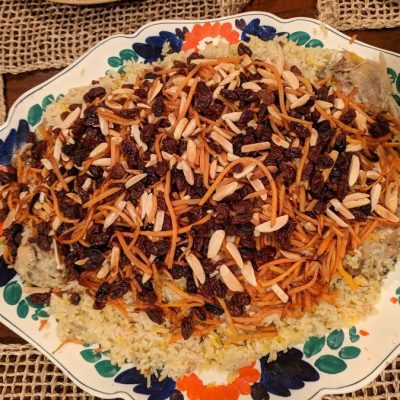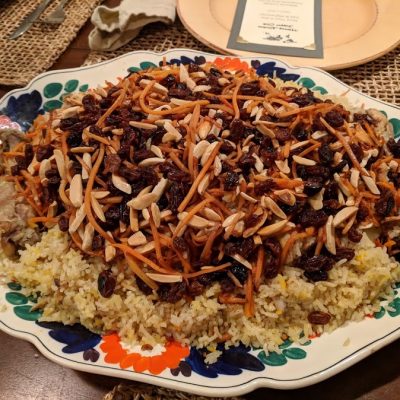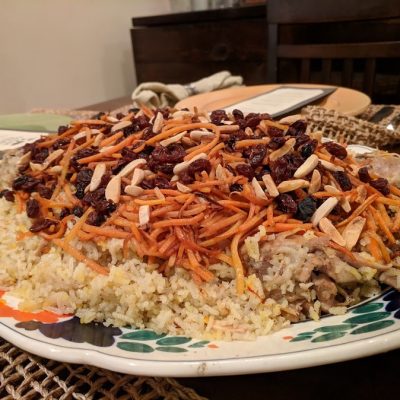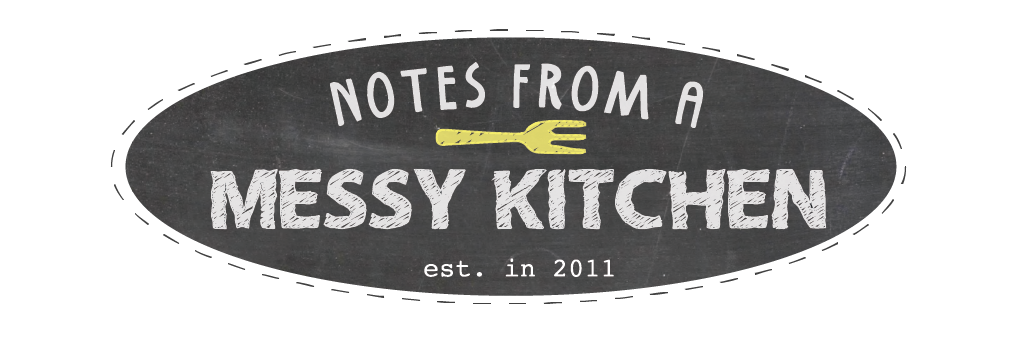



Qabuli palow (also kabuli pulao) is *the* dish in Afghanistan. It’s served at weddings, parties and pretty much all celebrations, and is considered the country’s national dish. Rice is an indication of wealth, and rice dishes are very important culturally. In fact, reputations can be made or lost on rice, and it’s said that an Afghan woman’s marriage prospects hinges on her ability to make palow. While I didn’t get any marriage proposals, my palow got high marks!
A bit more about the culinary traditions of Afghanistan. Generally speaking, Afghanistan’s cuisine is a fusion of many different influences particularly Indian, Persian, and Mongolian. Once distinction is that Afghan food is less spicier than its neighbors’. Rather than chiles, it’s very traditional for it to incorporate fruit and nuts.
The dastarkhan is an important expression of food culture in Afghanistan. Food is typically served communally, and this spread of dishes arranged on a tablecloth often laid on the floor might be as simple as tea and bread for the family, or could be a feast comprised of dozens of plates including palow, kormas, dumplings, breads, salads and sweets. Customs vary by region and ethnicity, but include the designation of a tea pourer, placement of the best dishes closest to guests, and the rule that one must never step on or over the dastarkhan.
Back to the palow. It’s typically made with lamb or chicken – I went with the latter, as our first course was lamb. Each recipe I reviewed was a little different, and I ended up referring to and borrowing from about four different recipes when all was said and done. This proved to be a bit challenging, because none of the instructions were particularly clear. It turned out in the end though, and the recipe you see here is primarily a combination of the palows from Life Art & Bites and Genius Kitchen.
|
1
Done
|
Heat 2 Tbsp olive oil and 1 Tbsp butter in a large sauce pan or dutch oven. Add the chicken pieces and fry until golden brown, turning throughout to cook evenly. Season with salt, pepper, 1/2 tsp cumin and garam masala. Add 5 cups water, or a bit more to just cover the chicken, and bring to a lower boil. Simmer for 15 minutes, then remove chicken and set aside on a plate. |
|
2
Done
|
Take 2 Tbsp broth and put in a small cup with saffron to create a saffron infused broth. |
|
3
Done
|
|
|
4
Done
|
Meanwhile, bring the broth back to a boil. Lower temperature to medium-low and cook the rice in it for 8 minutes - it should be softened but not all the way cooked through. |
|
5
Done
|
Stir the onion mixture and the chicken into the rice. Return to low heat, adding water as needed to ensure the rice cooks the rest of the way without burning, but not too much - you don't want it mushy. |
|
6
Done
|
Toast the raisins and almonds in a small skillet for about 2 minutes on each side, careful not to burn. |
|
7
Done
|
|
|
8
Done
|
One Comment Hide Comments
Afghans don’t put saffron in their qabuli. Iranians started using it when trying to make qabuli for the color. Authentic afghan Qabuli uses the color from the meat broth, which you did, but you don’t need the saffron but. But nice attempt. Thank you for your interest in Afghan cuisine